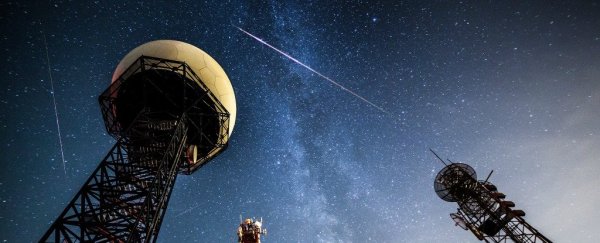Even if you're not a hardcore astronomy-geek, this month is looking seriously hot for staring up at the sky.
In coming weeks we'll have a lunar and solar eclipse forming a space sandwich around one of the most watched annual meteor showers on the calendar, making for a great opportunity to throw down a rug and gaze up at the stars.
About this time every year our planet passes through a cloud of dust and rock left by the Comet Swift-Tuttle, which last ventured into our neighbourhood in 1992 and will next swing by in 2126.
As the comet's dusty footprints hit our atmosphere, they briefly flare up in a spectacular display of shooting stars.
The tails of the meteors all seem to point to the northern hemisphere constellation Perseus, which is why the event is called the Perseid meteor shower.
While it's not the only show in town, the Perseids are typically regarded as the best. Most years sky-watchers can expect to see about 80 meteors per hour blaze across the heavens.
Last year's event was a doozy, with closer to 200 meteors per hour lighting up the sky thanks to Jupiter tugging at the comet's dust trail, allowing Earth to slip deeper into the stream.
Unfortunately we shouldn't expect such a rocking good show this year. In fact, we might be lucky to see half the usual number of meteors with a bright full moon intruding.
Still, it's worth a look. Head out on the evenings of August 11 and 12 and throw down a rug to watch the shower at its peak.
Don't worry about taking out a telescope or binoculars. Your best chance of enjoying the display is to just lay back and take in the whole scene.
"The Perseid peak is expected to occur at around 1 p.m. EDT on Aug. 12 this year, which is in the middle of the day," NASA asteroid expert Bill Cooke told Sarah Lewin at Space.com.
"This means there will be good rates on either side. I think things may be slightly better in the pre-dawn hours of the 12th, but there should still be a decent show on either night."
If you're busy then, Comet Swift-Tuttle's dust trail has already started to pepper the night sky with a few meteors, so you have an above average chance of seeing some fireballs tonight.
Even if the Perseids isn't at its best, we really shouldn't be too picky – on August 7, before the meteor shower gets fully under way, there's a partial lunar eclipse to check out.
If you're in Asia, Africa, or Australia, that is.
Lunar eclipses occur when the Earth casts a rusty coloured shadow on the Moon's surface, caused by light refracting through our planet's atmosphere like a contagious sunset.
The US doesn't miss out on the fun. They get the month's main event; a full solar eclipse will be crossing from coast to coast on August 21.
Be sure to be fully prepared for that one!
